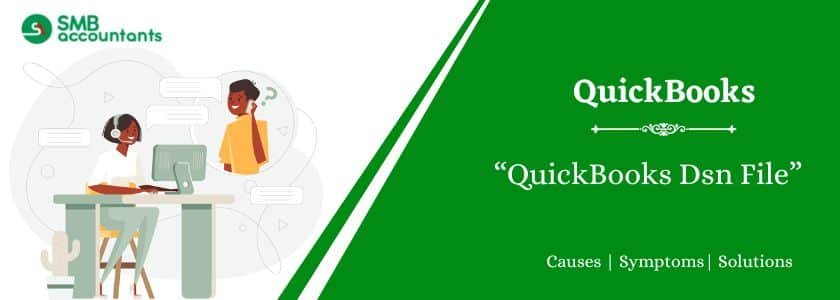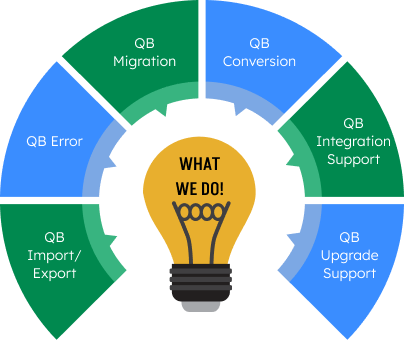QuickBooks is a richly featured accounting software developed with the main purpose of accelerating the growth of the business. The software simplifies the monotonous accounting tasks and improves the accuracy of the output. It saves abundant time and keeps the company data safe and secure.
The software saves the files with different QuickBooks file extensions on your computer. And this is what we gonna discuss along with the QuickBooks DSN file.
Table of Contents
What is the QuickBooks DSN file?
DSN (Database Source Name) is the extension attached to files that are used by the database client program to bind to a database through an ODBC (Open Database Connectivity) driver. The DSN file generally contains the user ID and password, the address of the server, the name, and directory of the data source, and other information. DSN files mostly store the data as plain text, but they can store it in the device registry as well.
Get Expert Advice to Fix All Accounting & Bookkeeping Problems

Why do we use QuickBooks DSN files?
Below are points to consider why we use QuickBooks DSN files:
1: Data Integration
DSN files allow other third-party software to directly access or connect to the QuickBooks software. With a DSN file, other software does not need to manually enter QuickBooks details and connection file details. Every time, the software can access QuickBooks data without facing any errors. This ensures that the integration and data exchange features between QuickBooks and external systems will perform optimally.
2: Enhance Reporting
Most business people rely on custom reporting tools that work with QuickBooks company data. These tools have direct access to the QuickBooks DSN file, which allows for advanced reporting and business intelligence. You can easily access the data in the QuickBooks DSN file when creating custom financial reports or researching sales trends.
3: Data Security
Using a DSN file, you can secure your store connection information and other company file details and ensure that sensitive information like login IDs and passwords are not exposed during the integration between QuickBooks and other software. Using a DSN file, you can secure your company data by adding an extra layer of security features at once.
4: Data Recovery
You can use a DSN file to create a backup of your QuickBooks company file data.
Type of Extensions in QuickBooks
They are as follows: QBW, .ND, DSN, TLG. The file extensions can be categorized as:
- *.QBW: It is used for major working file
- *.QBB, *.QBM: It is used for backup file types
- *.ND, *.DSN, *TLG: It is used for database support files
QuickBooks is no different than any other software, like others it also reads the data file:
What are the QuickBooks: Filename.qbw
This file extension .qbw is generally known as QuickBooks company data file or company file, or QuickBooks file. It is the primary data file that acts as a storehouse of all company financial records.
QuickBooks saves all the data files and views the location of the saved company file:
Start QuickBooks -> Open company file -> Press F2 -> Product Information page is displayed.
When the product information page opens, it displays all the important information about your QuickBooks and data, including the Data File Location. In case you want to back up your company data, you can do so by using the internal backup function in QuickBooks: Go to File -> Back Up/Create Copy.
Read this: How to Find QuickBooks Validation Code in Registry
What are the Backup File Types (*.QBB, *.QBM)
While creating a backup of your QuickBooks data, you get two backup options:
1. *.QBB:
It creates a backup of the QuickBooks QBW file and stores the crucial financial data of the company along with templates, logos, letters, and images. All the QuickBooks data should be backed up as a QBB file regularly.
2. *.QBM:
It is a portable and compressed version, especially for the QuickBooks QBW file’s financial data. It doesn’t include any template or logos. The QBM file is used when there is a requirement of sharing only financial data due to the smaller size of the file.
A backup or portable file is not the main working file but functions as a zipped file that you can restore should your company data file be lost or corrupted.
What are the Database Support Files (*.DSN, *.ND, *.TLG)
The Database support files are those that do not need to access directly.
1. *.DSN:
DSN indicates Data Source Name, which is a text file that comprises all the information needed for the QuickBooks program to connect to the QuickBooks company file.
2. *.ND:
ND indicates Network Data. It is a config. file that allows access to our QB company file.
3. *.TLG:
TLG indicates a Transaction Log, which is a log file that keeps track of changes to the file since the last manual backup (with complete file verification).
File Types and Extensions Used by QuickBooks Desktop
Common QuickBooks Files for Windows
| File Extension | File type | File Description |
| QBW | QuickBooks Company file | QuickBooks saves your company file with a .qbw extension, such as MyBusiness.qbw. |
| QBB | QuickBooks Backup file | QuickBooks creates a .qbb file when you back up your company data. Learn how to back up and restore your company file from a backup. |
| QBM | QuickBooks Bank Statement file | When you download transactions from your bank, QuickBooks opens them from a file with a .qbo extension. You can import a QBO file to quickly get transactions into your bank register. |
Need Professional Help?
Hope you are now much clearer on the concept of the Quickbooks DSN file. But if you are looking to get more info, then the customer support team is very prompt in handling the queries and problems reported to them by the QB users. Thus, hesitate no longer and reach out to us to get immediate support. Call our QuickBooks Pro advisor support phone number at smbaccountants.com.
Frequently Asked Questions
Q 1: How are QuickBooks DSN files classified?
Ans: QuickBooks DSN file is classified into three different types of files.
They are the following:
- .QBB, and .QBM, are known for backup file types
- .QBW is used for all major working files
- .ND, DSN, and TLG are known for database support files
Q 2: What programs can open a qbw.dsn?
Ans: The QBW extension is primarily associated with QuickBooks and serves as the file format for storing crucial information. These QBW files are considered the main data files within QuickBooks and encompass a wide range of financial data, including transactions, accounts, customers, vendors, and employees. Alongside financial information, QBW files can also house various elements such as templates, letters, logos, and images that are utilized within the QuickBooks application.
Q 3: What is the difference between ODBC and DSN?
Ans: A Data Source Name (DSN) is a logical name used by Open Database Connectivity (ODBC) to reference the driver and additional information needed to access data from a specific data source.

Adams Williams
Adams Williams is a seasoned accounting professional with over 4 years of experience in bookkeeping, financial reporting, and business accounting solutions. Specializing in QuickBooks software, Adams combines technical expertise with clear, accessible content writing to help businesses streamline their financial processes. His insightful guides and how-to articles are crafted to assist both beginners and seasoned users in navigating accounting software with confidence.



